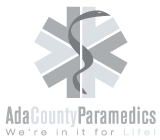For Ada County Paramedics
As the temperature begins to rise and the cabin fever is relieved, many of us find ourselves exploring the gorgeous and nature-rich country sides Ada County has to offer. Common outings in the area include, but are not limited to hiking, camping, trail riding, rafting/kayaking and horseback riding. As an Ada County Paramedic, I’m often asked what to do in emergency situations. And while it’s in some of our DNA to explore new areas, here’s a bit of paramedic wisdom: remember emergencies can happen anywhere. One of the most common outdoor emergencies involve snakes.
Remember, in their natural habitats they will protect themselves from objects (like you) they deem a threat. Encounters with most creatures of the land will be from a distance, but occasionally we may cross paths with a snake that has the capability of hurting you or a member of your group. Below are four important pieces of information to remember when in areas containing snakes.
1. Remain Calm
The most important piece of information pertaining to snake bites will ever hear is to remain calm! Although that may not be your initial response entering a state of panic heightens heart rates and blood circulation which increases the propensity of damage caused by the venom. If you’re in a secluded area and you’re bitten by a snake you believe to be venomous, calmly turn back the way you came and seek medical attention. Not every snake is poisonous and not every snake bite injects venom but it is still imperative to be seen by a physician. Do not wait for the onset of signs and symptoms to go to the ER. If you’re not somewhere entirely secluded and you have cell phone service, call 911 and let them know you have been bitten.
2. Prevention is the Best Medicine
When traveling in remote areas where there is potential to cross paths with venomous snakes, never travel alone. If possible, travel in groups of three. It’s valuable to have a companion stay with and help the affected person and another to travel ahead to seek additional help. Furthermore, you should always have proper knowledge of snakes and other native species residing in the areas you intend to hike or explore.
3. Never Attempt to Treat it Yourself
We know a little about handling a snake bite, but what should you not do if you’re bitten by a snake? Although you may have heard that cutting an “X” over the wound and sucking out the venom will help, don’t do this! Doing so has the potential to increase tissue damage and necrosis. Do not apply a tourniquet if bitten on an extremity, instead remove any jewelry or other constricting items. Snake venom destroys red blood cells and can cause a high amount of swelling. Tourniquets add to the impending edema.
4. Leave the Snake Be
Never waste time trying to identify the snake if it has left the area and DO NOT attempt to kill the snake. Doing so only adds to the chance that you will become a second snake bite victim and there’s no reason to punish the guy for trying to defend himself! Most anti-venoms are polyvalent, meaning they cover a wide range of venomous species.
In summary, there is no immediate treatment at the scene of a snake bite. Its important to be informed and cautious when traveling in areas with known venomous snakes. Always remain calm and remember the only definitive care for a snake bite is anti-venom located at the ER. Remembering these tips will help ensure you have a fun and safe summer.
For more information about Ada County Paramedics, like us on Facebook, follow us on Twitter and visit us on the web!
*This blog was not written by a physician and is only meant to provide precautions, not treatment, for snake encounters.


